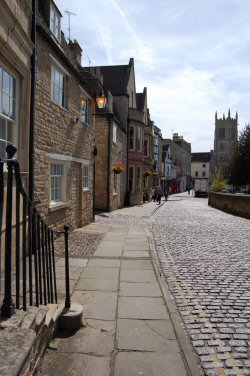Stamford history and heritage

Visitors have been drawn to Stamford for many years. Celia Fiennes, a traveller in the late 17th Century described it “as fine a built town of stone as may be seen”. Sir Walter Scott apparently doffed his hat to the view up to St. Mary’s Church, claiming it was the finest sight on the road between London and Edinburgh. More recently, Sir John Betjeman called Stamford “England’s best town”. In 1967 Stamford was made the first urban conservation area. A major book by the Royal Commission on Historical Monuments entitled ‘The Town of Stamford’ followed, detailing the long architectural history of the town and confirming the vitality of its unique built environment. In 2006, the Northfields area of town was also designated as a conservation area. You can find maps of both the Town conservation area and the Northfields conservation area on this web site. Stamford has three blue plaques, commemorating Sir Malcolm Sargent in Wharf Road, William Stukeley in Barn Hill and Nelson Dawson in St Mary's Street. There are a number of other plaques around Stamford, mostly dating from the 1920s, some rather more historically accurate than others. The Society has adopted a policy for supporting the provision of new plaques. Stamford's many listed buildings, churches and archaeological sites stand as testament to a past filled with creative and commercial endeavour. Add to that the achievements of its more famous citizens, ranging from Sir Malcolm Sargent to William Cecil, Colin Dexter and the notorious John George Haigh and you have a rich and colourful story to tell of a place and its people. Little wonder then that the town and the Burghley Estate receive so many visitors, all of whom come seeking to understand and appreciate the many sights which confront them as they wander the streets and parklands. This section of the website provides links to some of Stamford's many heritage sites. In this space we would like to pay tribute to Professor Alan Rogers, who passed away last year. He was well known for his scholarship and his in depth knowlege of Stamford's architectural heritage. Please read his obituary below. Professor Alan Rogers (25 Feb 1933 - 5 Apr 2022) Alan Rogers had a long and distinguished academic career as an adult educator and historian. A graduate of Nottingham University, he taught history in the Department of Adult Education there from the late 1950s until 1979 when he moved to Northern Ireland to become Director of the Institute of Continuing Education at Magee University College in Londonderry. In 1985 he was appointed Executive Director of Education for Development at the University of Reading, where he set up his own NGO, Education for Development, working on adult literacy and non-formal education. He was Visiting Professor at the School of Educational Studies of the University of Surrey from 1988 to 1995. In 1998 he was made an Honorary Professor at Nottingham University’s School of Continuing Education and from 2005 he was also Visiting Professor in Adult Education at the School of Education and Lifelong Learning at the University of East Anglia, positions that he held to the end of his life. As an international expert in the field of adult education and informal learning, his particular interest was in the training of teachers of adults in the context of international development programmes. As well as writing a number of books on adult education and international development, he organised research and training projects in many African and Asian countries, including Ethiopia and Afghanistan. His other great passion was local history, especially the medieval history of Stamford. In the late 1960s, during his time in Nottingham, he became a member of the newly-founded Stamford Survey Group (SSG), for whom he took the lead in editing and writing a series of historical and architectural accounts of the town’s ancient buildings and institutions. As well as his academic publications, his output included two general histories of Stamford. A Fellow of the Royal Historical Society and of the Society of Antiquaries, Professor Rogers was President of Stamford and District Local History Society from its inception in 2013, as successor to the SSG, until his death in 2022. A selection of his books relating to Stamford is shown below. He also contributed articles to The Stamford Historian between 1977 and 1982. Selected titles Alan Rogers (ed). The Making of Stamford. Leicester: Leicester University Press, Alan Rogers. A History of Lincolnshire. Henley on Thames: Darwen Finlayson, 1970 Alan Rogers. The Medieval Buildings of Stamford (Stamford Survey Group Report 1). University of Nottingham Department of Adult Education, 1970 John S Hartley and Alan Rogers. The Religious Foundations of Medieval Stamford (Stamford Survey Group Report 2). University of Nottingham Department of Adult Education, 1974 Alan Rogers and John Quinlan. A Short History of the Stamford & Rutland Hospital. The Friends of the Stamford Hospital in association with the Stamford Survey Group, 1978 Alan Rogers. The Book of Stamford. Buckingham: Barracuda Books, 1983 Alan Rogers (ed). William Browne’s Town: The Stamford Hall Book, Vol.1: 1465-1492. Stamford Survey Group in association with Stamford Town Council and Stamford Civic Trust, 2005 Alan Rogers (ed). The Act Book of St Katherine's Guild, Stamford, 1480-1534. Abramis, for the Stamford Survey Group, 2011 Alan Rogers (ed). People and Property in Medieval Stamford. Abramis, for the Stamford Survey Group, 2012 Alan Rogers. Noble Merchant: William Browne (c.1410-1489) and Stamford in the Fifteenth Century. Abramis, 2012 Alan Rogers (ed). The Wardens: Managing a Late Medieval Hospital. Browne's Hospital, Stamford 1495-1518. Abramis, for the Stamford Survey Group, 2013 Nick Hill and Alan Rogers. Guild, Hospital and Alderman. Abramis, in association with the Stamford Survey Group and the Browne’s Hospital Trustees, 2013 Alan Rogers. William Cecil’s Survey of Stamford 1595: A Town in Turmoil. Bury St Edmunds: Abramis, 2020 |
|




